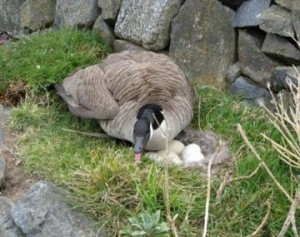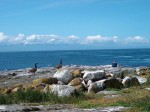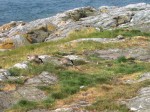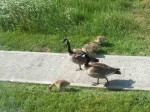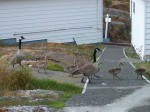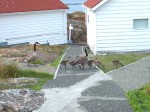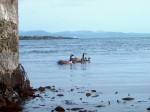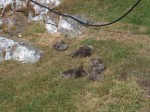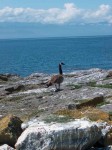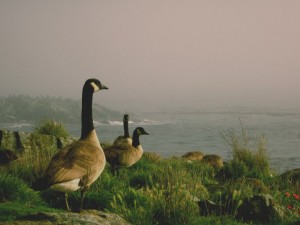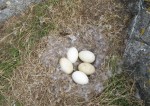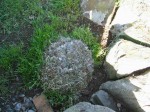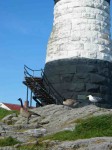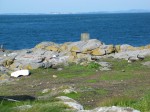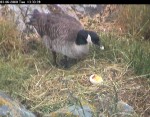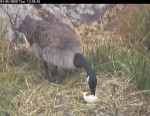Race Rocks Backgrounder
A pair of Canada geese has regularly visited the island in the early spring over the last few years, but until the summer of 2002, they stayed a short time and then moved on. In 2002, Carol noted that two pairs of geese came in the spring and seemed to be staying an extra long time. They were joined by another pair occasionally but had many territorial disputes. In early May the reason was apparent. Five tiny goslings showed up one day with their parents. Carol documented their activities frequently in the Racerocks Log.
- Parents on the lookout
- Grazing time
- A mess on the pat
- Geese Xing Keep in step Pictures taken June 10/03 by Ryan Murphy
- Geese Xing
- Out for a swim
- Snooze time
- Sentinal
All five goslings made it to maturity that summer, probably assisted by the fresh water fountain which was their daily waterhole during the dry months. From September on, 6 of the original 7 geese frequently returned to the island, and have been seen here as late as January 2003. Update: Successful hatches of 4 nests occurred in 2004. In 2005 at least 4 pairs are nesting. Now when they hatch, the young are immediately taken off the island by their parents since there is no fresh water source on the island.
In the spring of 2008, and addling cull was done on permit from Canadian Wildlife permit arranged through BC Parks. There were no successful hatches that year. This had to be done because of the serious level of overpopulation of geese on the island. The integrity of the vegetation was starting to be impacted.
Physical Characteristics: Canada Geese have a black neck, bill and head with pronounced white patches and strip under the chin. The body is usually brownish-grey. During flight the tail shows a white half-circle just above the black tail. These colour patterns are unique to this species. Females are usually somewhat smaller than the males, although both are similar to each other in colour. The mass of the Canada Goose varies in every species ranging from one to four kilograms. Goslings, or baby geese, are yellow with some greenish-grey colourings on the top of the head and back.
Food Habits
When on land, Canada Geese eat mostly grass and wild barley. They are able to grab a hold of each blade and pull it out with their bills by jerking their heads. They also eat wheat, beans, rice, and corn. In the water, the birds stick their head and upper part of their body into the water leaving their tail and back end extending in the air. They stretch their neck out, under the water, and slide their bills across the bottom silt. They also eat a number of aquatic plants such as eel grass and sea lettuce.
Behaviour
- Eggs, April 2007
- A nest covered up while the parents are foraging.
- Sentinel near tower
- Sharing a spot in the sun with the Black Oystercatchers, spring, 2005
- On June 3/08, PB captured these images of the goose eating her own egg which had not hatched
- his goose had only one egg, and had sat on it for at least 40 days
Males in this species are very aggressive. They use their bills not only to eat and groom, but also in attacks. They also lay out flat and still on the ground with their necks stretched out to be less visible to the danger. Most geese mate for life. They form pairs during migration or on wintering grounds. Males fight over females with their wings and bills. The winner approaches the female with his head down and neck undulating. He makes hissing and honking noises. They usually mate either before or after they have found a nesting location. Mating occurs in the spring on the water.
| Domain | Eukarya |
| Kingdom | Animalia |
| Phylum | Chordata |
| Subphylum | Vertebrata |
| Class | Aves |
| Order | Anseriformes |
| Family | Anatidae |
| Genus | Branta |
| Species | canadensis (Linnaues) |
| Common Name: | Canada Goose |
Environmetal Impact : Although we have had a permit to addle eggs for several years, the introduced Canada goose variety has had a serious impact on vegetation through intensive grazing through the winter. By including several grazing exclosures with wire mesh around the island, the difference in turf development is emphasized.
A serious impact also is the increased erosion around the First nations burial cairns.
References:
Canada Goose, http://www.mbr-pwrc.usgs.gov/id/framlst/i1720id.html
Backyard Birding, http://www.slivoski.com/birding/goose3.htm
Canada Goose, Branta Canadensis, http://www.aquatic.uoguelph.ca/birds/speciesacc/accounts/ducks/canadens/account.htm
The Atlas of Breeding Birds of Alberta, Ed. Glen P. Semenchuk. Edmonton: Federation of Alberta Naturalists, 1992.
Return to the Race Rocks taxonomy
| This file is provided as part of a collaborative effort by the students, faculty, staff and volunteerts of Lester B. Pearson College | 12/02 | Bruce Benjamin D’Souza (Yr 29) |

